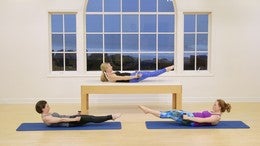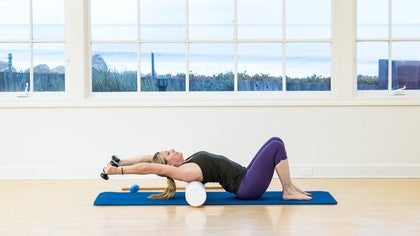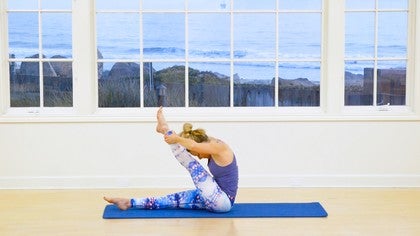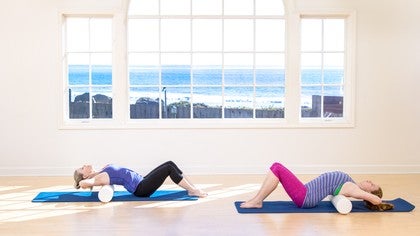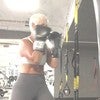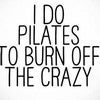Description
About This Video
Transcript
Read Full Transcript
Hi everyone, Amy here for a segment. I'm not gonna really call this a class, so much, as a little segment of some thoracic mobility and shoulder mobility exploration, really. So, what you're gonna need for this class, a stick, or a broom stick or a gondola pole. But I just have a stick from the Wonder Chair, one of our combo chairs. A foam roller.
Yes, I have the blue balls here, but they're different they're taped together. So, you just might know what these are for. They're for thoracic mobility, we'll get there. And some hand weights. And I have three pound hand weights, you can use lighter, but the heavier is gonna be better.
We want it for some challenge for shoulder flexion and some active tension. Okay, I'll get there in a few minutes. But let's start standing and, first of all, just put this stick down, take one of your hands. We're just gonna focus, first, on your shoulders. Okay.
And just kind of testing some range of motion and some stretching. Don't go crazy with this, but first one, take one of your hands and put it right behind the small of your back, okay. And that might be enough for you, and if so you can just hang out there. But if not, if you want a little more, take your opposite hand, reach around the front of you and hold onto your elbow and then gently give some resistance between that elbow and your hand. Okay, so my hand is around the back of my elbow, and I'm trying to pull my elbow back a little bit.
Just holding. So why I've chosen to do this type of segment today is my own personal curiosity and exploration in my own shoulder range of motion, my own thoracic spine mobility, finding restrictions and trying to study them. And as we explore through our Pilates work, we all know that we come across some things now and again where maybe they weren't there a week ago or a month ago or a year ago. And that's our opportunity to go in and take a look at it and feel and learn about it, okay. And even though I've been doing this a long time, I'm still very, very curious all the time about how I can move more freely and more efficiently.
And a lot of times it's in my thoracic spine and my shoulders. So that's what today's for. And I know there are lots of us out there that share that place in the body. Okay, so done with that. You can let go gently and just hold your arm down and kind of shake it and just feel.
Probably felt some stretch around your deltoids. Okay, let's do the other side. So hand behind your back, other hand around and give a little gentle resistance. And I will say on a lot of these stretches like this standing coupled here think about the organization of your rib cage. So I definitely don't want us to be efforting, you know grabbing the elbow here.
And sacrificing the placement of the ribs and having you stand with yourself in an arch. So do attend to that and try to keep yourself aligned if this is too difficult to hold, then don't. You just, you know, maybe you'll get there. Maybe you're walking your hands toward it, okay. We're just holding for a couple of breaths.
Gonna recreate a little resistance, I'm pulling on my elbow, but I'm also trying to pull my elbow back a little bit. Yeah, and you could actually put your hand in front too, maybe, and push against your fingertips. You can do a little bit of both. One more nice breath in and out. And release and just kind of feel.
So, probably, likely to feel the same spot in your shoulders. Yeah, just swing your arms a little bit. Okay, now's the time to grab a stick and we'll move onto the second shoulder stretch. So put your stick right behind your back, much like a back scratcher, kind of, (mimics scratching) like this, and then you're gonna align it. You have to hold onto the bottom end here, okay.
Now let's turn around. Where I want you to put the side of the stick is not in between your shoulder blades in there, it's difficult, more out here on the lateral border of your shoulder, and then that's going to be easier for you to hold the bottom end. And then just gently turn. Take this bottom hand and pull up a little bit, okay. Don't worry about the top hand so much, unless you want to.
You could apply a little bit of pressure with this palm against the stick and pulling this one up. So we're gonna rotate our cuff. One of the many... Well there's four in there, muscles as you know. Super spinalis is getting mainly the attention here.
Take a few deep breaths. And also this is helping assist that upper arm bone, your humerus into external rotation. We all know that's very important when trying to add and gain more skill in upper back extension. Which I'm working on. And I'm sure some of you are working on too.
Let's hold one more breath. Okay, these can be on the daily or weekly stretches. So let's go ahead and let go and compare and contrast. Should feel pretty good and different, but let's do the other side. So, as if you're scratching your back, hold around the front, near the bottom.
And again you want to get that stick on the lateral border of your shoulder, your elbows slightly pointed out, bottom hand pulls the stick forward, allow that top hand to come back. And again, you can use as much or little resistance here as you like. This top hand can pull against the stick, this one can pull up. But once again you're inviting that upper arm bone into that external outward rotation. Keep those ribs aligned and just feel, deep breath.
So think about all the places in the Pilates syllabus, all the equipment, all the mat, where you need more skill in external rotation, right. Lots of places. And it also into that upper back, the swan. Whether you're just on your mat or swan on the equipment, the pull ups on the table, a lot of different things you want. Strong mobile shoulders and thoracic spine, okay.
So let's go ahead and just let go and you can put your stick down. And then just kind of assess for a second how your shoulders feel here. Hopefully fairly good. Palms face up, this is a fairly easy one. I want everyone to just take their palms out.
I'm now pointing my fingertips to each wall in the room. I don't necessarily need you to pull your elbows too closely in towards you yet. But you will in just a second. But pretend for a second you have that stick in both hands and you're rotating this way. Okay, that might be enough for you.
If not, if you want a little more, come along. I'm gonna pull my upper arms now in toward my body without thrusting the ribs. And let's just go out. And in. And inhale, stretch out.
You certainly could do this with a theraband, but think about pulling your upper arm bones and elbows in towards your waist. While you have that externally rotated upper arm. A little bit faster maybe for five. And in. And four.
Really pull in, yeah. Notice the thumbs are pointing back. You see me do that in lots of classes, you can make your soft fist if you want. Pull in. Two more.
Externally rotating those upper arm bones. And last time. Now pull in, hold in, I'm gonna just slightly turn to this side for a second. And if you want to test right now to see how much upper back arch can you do. Just a little bit or maybe a lot.
I'm not bending my low back, I'm trying to think about going up and back, externally rotating those upper arms. This is great for being at the desk, if you're at the desk all day. Just do this once or twice. You can, kind of restore, some funky posture too. Okay.
A lot of what this class can help with. Let's go floor bound, we're gonna go down. And I think what I want to start with now is how to work with these magic balls. So put them on the floor, you are gonna aim to put yourself on the balls. Not right at your shoulder blades here, not there, but in between, and maybe just down a little bit.
Okay, to start with. And just good luck with it, you're gonna have to eyeball and get yourself there. Feel free to move a couple of times to get in position. Okay. Right.
So, why I'm doing this is to give us some sensation, some awareness into that thoracic spine and the musculature and tissues in that position and in that place. So, right now, these are lacrosse balls by the way. So they're pretty firm. You could certainly use tennis balls. But I want you to just start rolling a little side to side like this.
I'm gonna do a little bit of, kind of, roll slower so you can see, whew, very clear feeling of what's going on. I'm gonna move a little bit into upper back, just a slight upper back extension and flexion. Y'all keep going, I'm gonna turn myself sideways now so you can see more of the profile version of what's going on, keep moving. Okay, you keep moving. But this way you can see what we'll be aiming to add in here with our shoulder flexion as well.
And get myself there yeah. Okay, whoo it's a very sharp sense. So you can add a little bit of upper back extension, much like you would do over the roller and a little bit of flexion. Okay, keep it small. That pressure is pretty firm.
And if this is too much, certainly, take the time to go change the balls or even just do this on some rolled up socks, that might be fine too. Just, you want some sense of the pressure though. Okay, now I'm gonna move my hips down a little bit, so that makes the rollers go up my back or the balls to go up my back. Right between the shoulder blades now. And I want you just to move a little bit.
Find a way that you can move. And do little circular movement. Loosening up the shoulder blades on your ribs. Okay. A couple more moments of that.
You can handle it. So the upper back being a place that gets pretty tight, pretty weak, sometimes restricted in these joints. Which makes shoulder flexion tricky and sometimes challenging. So we've got to free up this spot, sometimes, before we can free up these guys, okay. So I'm gonna try something now and you can test with yourself.
Stay on the balls, let go, and then just see where your shoulders, your arms go. Just gonna keep my head down for a second. Okay, just do a few movements there. Keeping your hips on the floor at this point, just gonna test where you're at. One more, should be plenty.
And yeah, the ball's pretty... These are pretty firm balls like I said, so, I'm gonna arch over that a little bit more now. So that I can keep my trunk stable and try to access more shoulder flexion for a second. Try one or two more now, there. Give your weight to the balls.
Just give your body weight down. Okay, one more, I promise and then we're gonna get up off of these things and work on the roller. Whoo, oh yeah, interesting sensation. Okay, so help yourself up, take those away. Now move your roller into position, this way.
And this is the time to bring your hand weights towards you. Okay, and at first, let's just go ahead and position ourself down. You've all done these before. Just get yourself over and the same thing. Test.
So I have my shoulder blade tips on the roller and see where your shoulder flexion is, right. Hopefully pretty good. If you want a little bit more, we'll go there in just a second. Alright, so before we add the hand weights, lift your pelvis up, take your arms up, I've let my upper body and my head go all the way now and see if you can take your arms all the way to the floor. I'm actually gonna keep my head there.
Okay, now my head is on the floor now, hands on the floor. Now, with the hips up like this, arms overhead, what I'm anchoring here are my arms, okay. So let your arms stay down the best they can and start to bring your hips back down to the floor. So you are seeing some of my restriction, it is okay, I'm working to change it. My goal would be that this would get to the mat.
So I've got a lot of bit of mobility to discover and some flexibility to find in there, in those tissues. Okay, but having some extra weight is going to aid that and help that. So I'm going back up again. Hips up. So why I wanna have the weights help me, I need some extra feedback for those tissues to change.
So I'm going up slowly, again, I'm gonna take those weights down. There we go, head is on the floor, hips are still up. Now, let's see what we can do. I'm gonna take a breath, I'm gonna ask my ribs to come into my body. Although, I'm still arching and I am trying to get my hips a little bit closer and I feel like they're moving a little bit more.
And again, hips up. So the arms being the stable things, my body, my spine, my trunk moving between the arms I got there. Two or three more. Whoo. So the weight's helping to hold my arms down so that I can move my spine.
I'm gonna move the roller up my back and see what I can do up here. Okay, similar story. Whoo, might be harder. I don't know, might be easier, we're gonna find out. I mean it's easier, yay.
So these segments might have more freedom than the ones below it. That's what we saw in that restriction. So my upper thoracic might be more mobile than I gave it credit. Let's, aw yeah. Stretch the arms.
How about one more. And down, head is down, arms are back, butt goes down. Okay, bend your elbows, bring the weights in. Gonna do one more thing with that. Oh my gosh that feels so good.
Okay, similar with the hips up, take your weights up and take yourself back over again slowly, okay. Now let's strengthen along with that, so now that I know that I've been able to get my pelvis down and hopefully you got there too, if not keep working on it, okay. Put your hips down. What we're gonna try to do is lift the weights off the floor but I'm not really going to. I'm just gonna kind of stiffen those muscle tissues as if I'm gonna lift.
And then release and things are usually gonna be a little more free. And same thing. Trying to lift them. Do you see how I kind of tensed my arms. And then release, I'm getting a little more mobile here, one more time.
And, try to stiffen. Oh I did really lift them, down. And bend. And come up slowly, okay. Pretty invigorating.
Now let's just see what I've got. I'm gonna take the roller away. I should've done a full comparison and contrast, darn it. When I was completely flat on my back, but you're gonna see most likely, much freer shoulders. I did it, my shoulders and my hands are down.
Now I get super excited, so excited because, this has been my measure for myself for a very long time. That those tissues being restricted, tight, whatever we want to name them, I haven't been able to get my arms completely down, right. But you just saw the success of doing so, I should have done the compare and contrast, but I promise, I promise. Okay, so just feel the freedom of that, and think about all the places in your Pilates repertoire that you need that freedom of your arms overhead without your teacher, or your internal teacher saying, "Close your ribs," or, "Knit your ribs," or anything. It's not the ribs that are the problem, it's the thoracic spine mobility that needs attention.
Not our ribs, okay, so be good to yourself. Take two or three breaths, maybe open your arms out to a T, take in your space, give yourself credit for taking yourself through that, kind of, interesting segment. Let me know how it goes for you, you guys, I love your feedback and especially those of you who do have shoulders like mine or thoracic spine like mine. Try this and I promise, you're gonna have improvement. Let me know how it goes, bye.
Pilates with Amy Havens: Restorative Workouts
Comments
You need to be a subscriber to post a comment.
Please Log In or Create an Account to start your free trial.
